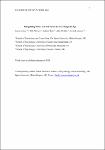Recognising newly learned faces across changes in age
| dc.contributor.author | Sexton, L | |
| dc.contributor.author | Mileva, M | |
| dc.contributor.author | Graham, H | |
| dc.contributor.author | Strathie, A | |
| dc.contributor.author | Laurence, S | |
| dc.date.accessioned | 2024-02-06T12:16:06Z | |
| dc.date.available | 2024-02-06T12:16:06Z | |
| dc.date.issued | 2024-03-07 | |
| dc.identifier.issn | 1464-0716 | |
| dc.identifier.issn | 1464-0716 | |
| dc.identifier.uri | https://pearl.plymouth.ac.uk/handle/10026.1/22034 | |
| dc.description.abstract |
IWe examined how well faces can be recognized despite substantial age-related changes, using three behavioural experiments plus Mileva et al.’s (2020, Facial identity across the lifespan. Cognitive Psychology, 116, 101260) PCA + LDA computational model of face recognition. Participants and the model were trained on a set of faces at one age (with each facial identity depicted in multiple images) and tested on their ability to recognize those individuals in images taken at a different age. The younger images were aged 20–30 years and the older images were either 20 or 40 years older. The computational model showed high accuracy, but it performed better if faces were learnt in their younger versions and testing was with the older images than vice versa. The humans did not show this age-direction effect. Although their recognition of faces across either a 20- or 40- year age gap was poor, it was significantly above chance, suggesting that we can extract identity diagnostic information despite substantial changes in outward appearance. | |
| dc.format.extent | 617-632 | |
| dc.language | en | |
| dc.publisher | Taylor and Francis Group | |
| dc.subject | Face recognition | |
| dc.subject | facial ageing | |
| dc.subject | face perception | |
| dc.title | Recognising newly learned faces across changes in age | |
| dc.type | journal-article | |
| dc.type | Article | |
| plymouth.issue | 8 | |
| plymouth.volume | 31 | |
| plymouth.publisher-url | http://dx.doi.org/10.1080/13506285.2024.2315813 | |
| plymouth.publication-status | Published online | |
| plymouth.journal | Visual Cognition | |
| dc.identifier.doi | 10.1080/13506285.2024.2315813 | |
| plymouth.organisational-group | |Plymouth | |
| plymouth.organisational-group | |Plymouth|Faculty of Health | |
| plymouth.organisational-group | |Plymouth|Faculty of Health|School of Psychology | |
| plymouth.organisational-group | |Plymouth|REF 2021 Researchers by UoA | |
| plymouth.organisational-group | |Plymouth|Users by role | |
| plymouth.organisational-group | |Plymouth|Users by role|Academics | |
| plymouth.organisational-group | |Plymouth|REF 2021 Researchers by UoA|UoA04 Psychology, Psychiatry and Neuroscience | |
| plymouth.organisational-group | |Plymouth|REF 2021 Researchers by UoA|UoA04 Psychology, Psychiatry and Neuroscience|UoA04 Psychology, Psychiatry and Neuroscience MANUAL | |
| plymouth.organisational-group | |Plymouth|REF 2028 Researchers by UoA | |
| plymouth.organisational-group | |Plymouth|REF 2028 Researchers by UoA|UoA04 Psychology, Psychiatry and Neuroscience | |
| dcterms.dateAccepted | 2024-01-22 | |
| dc.date.updated | 2024-02-06T12:16:05Z | |
| dc.rights.embargodate | 2024-3-23 | |
| dc.identifier.eissn | 1464-0716 | |
| rioxxterms.versionofrecord | 10.1080/13506285.2024.2315813 |


